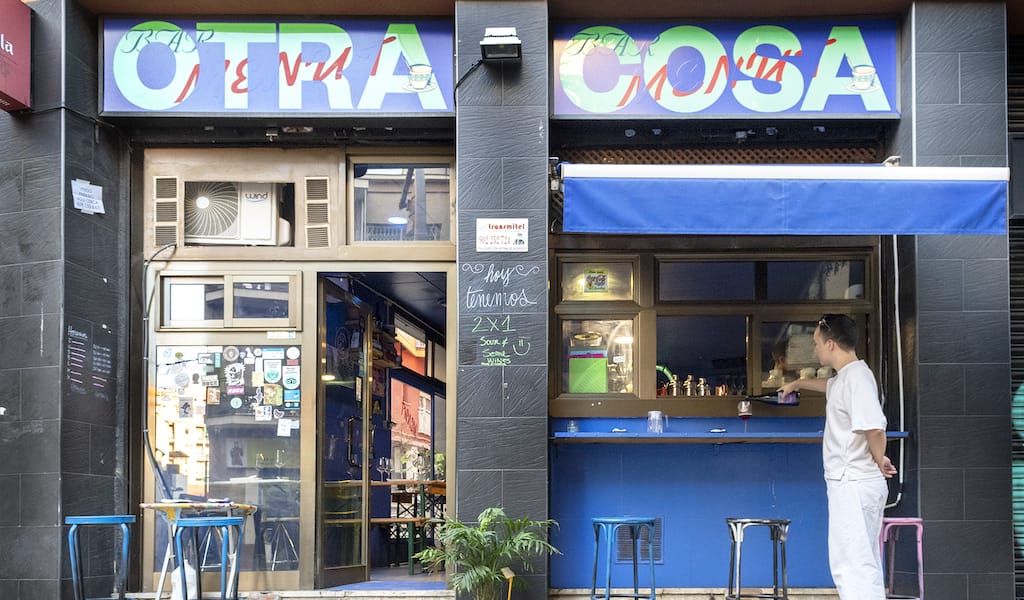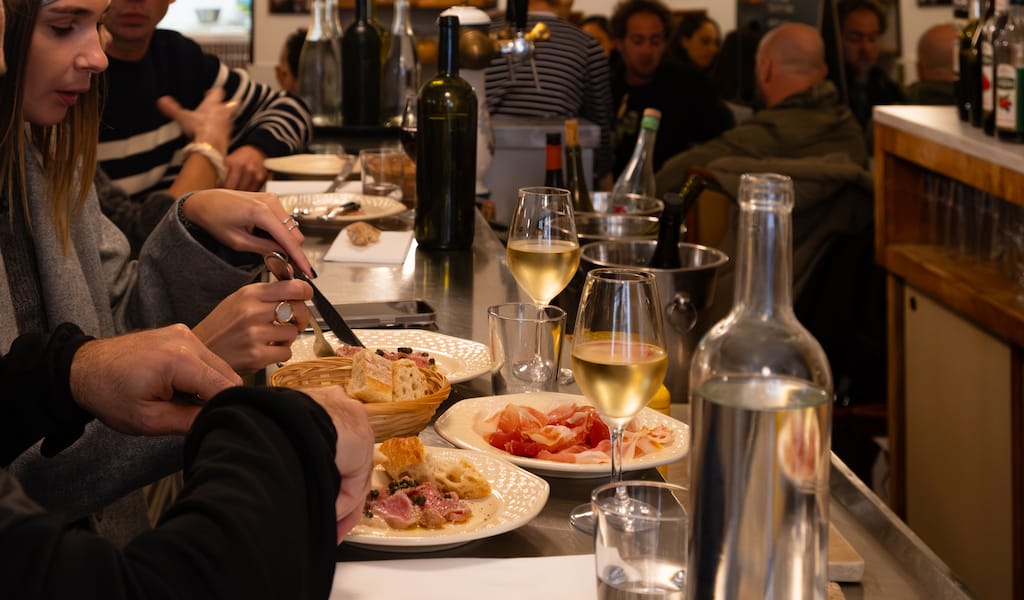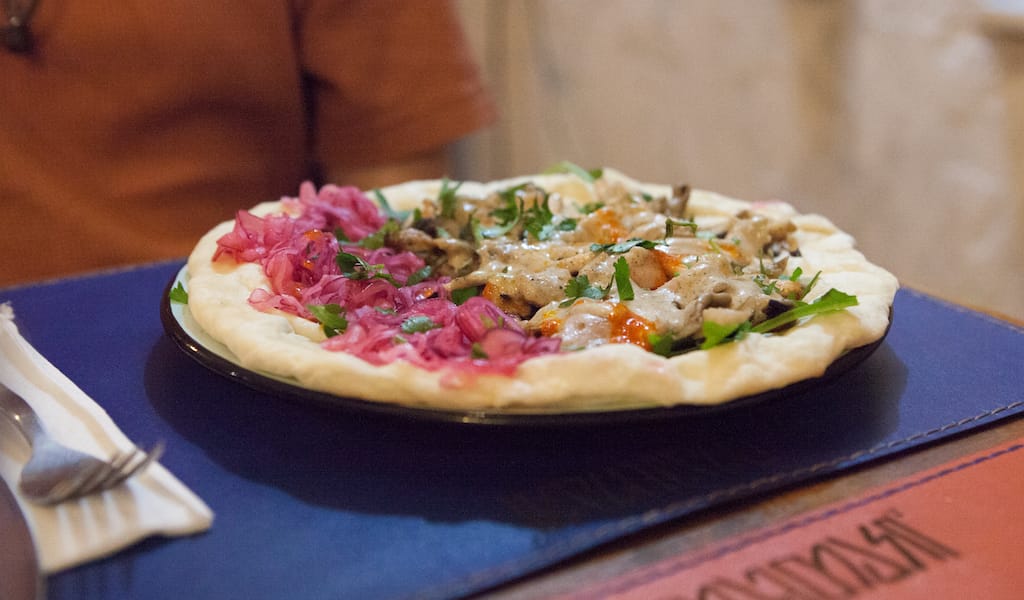The post-punk cultural movement of the 1970’s could be described as a period of breaking with traditional elements, embracing the avant-garde and mixing a variety of different influences. It’s also how chef Felipe González describes his restaurant, Otra Cosa Taberna (which translates to “Something Else Tavern”), located in the neighborhood of Sant Andreu.
“I like to define Otra Cosa Taberna as ‘post-punk market cuisine’ because is very much a market cuisine; we buy what the neighborhood has to offer,” Felipe explains. “But we’ll also do with these products whatever we want. The interpretation of cuisine, for us, is super free and very ambiguous. You might be eating a Peruvian causa but with octopus and a mayo with olivada, and we totally flip it to present it in a completely different way. The game has no limits.”
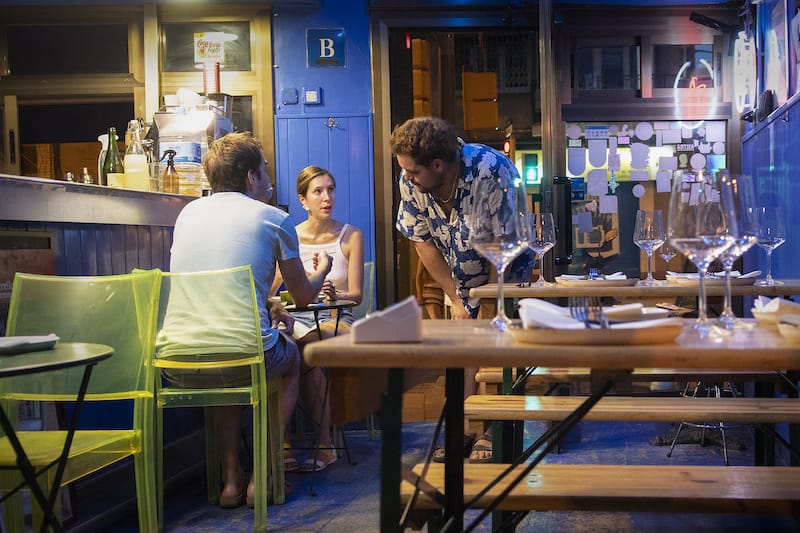
Otra Cosa resides in a former old-school tapas bar, a small, narrow space which has been painted a deep blue. The no-limits approach applies to both food and decoration here: natural wood accents mix with acid-green plastic chairs and sticker-filled windows, an eclectic-yet-cozy setting for Felipe’s post-punk culinary proposal. A number of different bottles of natural wine await in a bowl of ice, hinting that this is no longer your standard tapas restaurant.
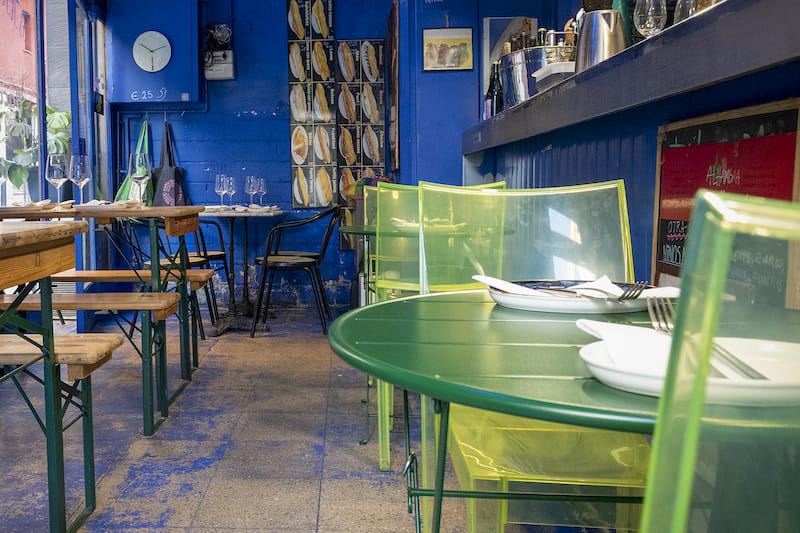
Gerald Sánchez, the room manager, is busy overseeing final details before opening, and sous chef Vero Boulhesen prepares the kitchen to receive the first customers of the evening with the day’s special, a seasonal dish of scallops. Felipe is the creative force behind Otra Cosa, but he can also be found attending tables and cleaning, just like one of the team. We watch him flit from the kitchen behind the bar to the dining room, speaking with each of the customers personally at some point during the night. When he can, he receives visitors at the door himself. “This is my home!” he says. “Many people come and they don’t even look at the menu. They say, [we’ll have] whatever Felipe wants to bring us to eat!”
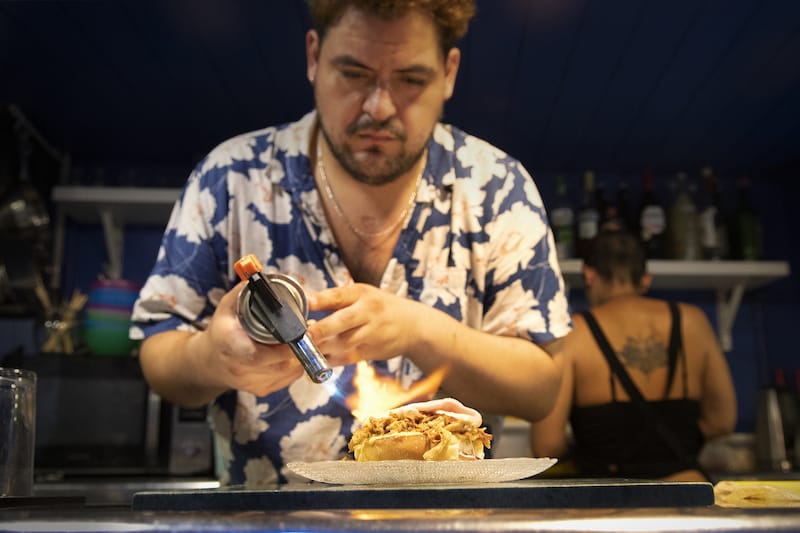
The menu at Otra Cosa is an intersection of Latin American, Asian and Mediterranean cultures, concepts, ingredients and flavors; including, of course, many Catalan and Spanish references and products. More than a strategic decision, these dishes are an edible representation of Felipe’s life and influences “This menu is my journey; it is who I am,” he says. Felipe is from Iquique, a town in northern Chile, on the border with Peru. His fascination with food began there, with the feasts his grandmother cooked at home for the family. Later, he spent a few years studying English in San Francisco, California, where many of his classmates were Korean, and together they started to cook and share recipes in their hostel’s community kitchen. This further inspired Felipe and his love for gastronomy, and he returned to Chile where he began his studies to become a professional chef, which he would go on to complete in Barcelona.
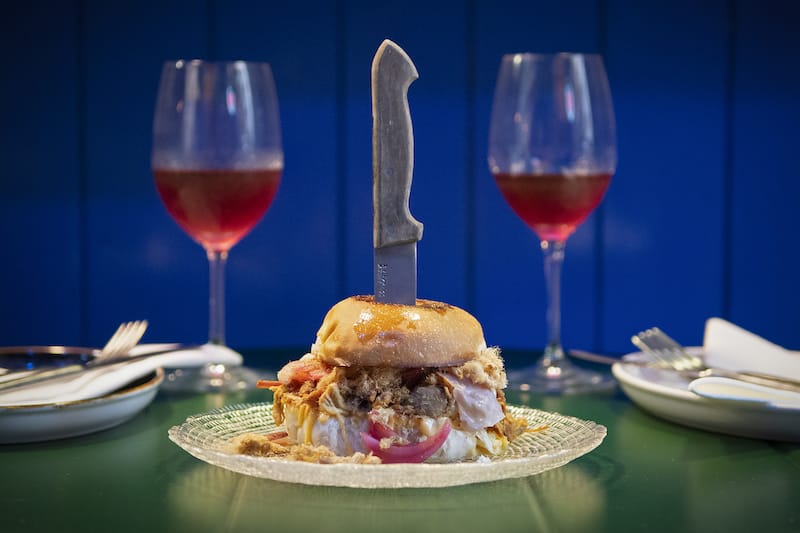
After several years of hard work in a number local restaurants and hotels in Barcelona, he opened the first iteration of Otra Cosa in the Born neighborhood in 2019. When the Covid-19 pandemic hit, he was forced to leave, seeking a location for his restaurant in a less central – and expensive – neighborhood. Felipe, however, saw this as a chance to develop and expand the concept he had in mind. “When we moved to Sant Andreu we started with this idea of crossroads dishes, but still keeping some ‘must-haves’ I wanted on the menu, like the best Russian salad in Barcelona, a great ceviche, natural wines and a couple of cool sandwiches,” he recalls. Sant Andreu is an animated, residential middle-class area, full of classic small restaurants and bars. It’s full of neighbors walking the streets, enjoying the outdoor seating at restaurants and bars and doing their shopping at local markets and grocers. Felipe is part of the neighborhood here, and he considers his nearby suppliers a part of the team. He sees great value in being able to trace his ingredients to their source: “It is a poetic element I enjoy very much.”
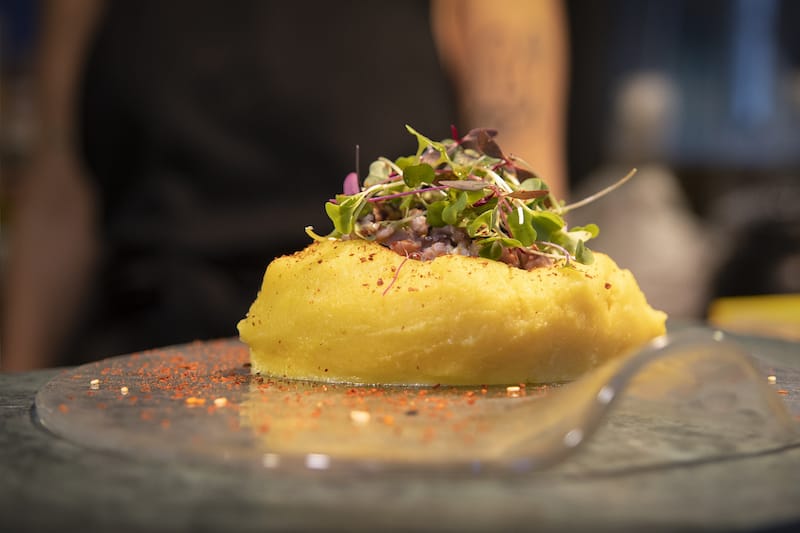
“What’s the dish you would come back for?” he asks. Honestly, we would come back for many of them, but especially the Ceviche Nikkei. This dish is inspired by Peruvian chef Ciro Watanabe, Felipe’s mentor in Chile. “The dish in inspired in him and in the sea,” Felipe says. Its ingredients include tuna, salicornia, wakame, yuzu-injected spheres, nori seaweed, fried onion, and Peruvian leche de tigre marinade – succulent flavors, soft spiciness, balanced acidity and a diversity of textures make this ceviche worth crossing the city for.
A close runner-up is the Bomba de la Barceloneta. Completely different from the traditional version of this dish (a local treat which consists of a fried ball of mashed potato with meat inside, topped with a spicy sauce), at Otra Cosa, the “bomba” is transformed into a Peruvian causa, a traditional layered-potato dish. The yellow ají potato has the texture of a cold parmentier, finished with an octopus tartar with Japanese Kewpie mayo, a Basque piparra green chili paste, smoked salt, cornichons and anchovies, bringing the umami through the roof. The result even evokes a deconstructed Galician style octopus with potatoes.

Finally, we’d return time and again for the Tres Porquets (“the three little pigs”), Otra Cosa’s bestseller sandwich. This melt-in-your-mouth pulled pork specialty is served on a bun from the local Venezuelan bakery Bendito Pecado in El Born made with pineapple juice and honey, making the bread sweet and moist. The sandwich’s fillings change, but on our visit it came stuffed with a combo of three delectable cuts of Iberian pig: lagarto ibérico, pluma ibérica and secreto ibérico. To this, Felipe adds the magic texture of pork floss (Chinese-style shredded dried pork meat), a homemade barbecue sauce, and another of Otra Cosa’s house mayonnaises.
The food is intense and exuberant, a testament to the chef himself. “I’m an intense person and I love this intense experience,” says Felipe. “We look for a lot of flavor, textures and possibilities. Because this is who we are. If I’m doing something I’m going to put everything on it!” Beyond the menu, we will happily come back for that which makes the free-form Otra Cosa quite traditional, in the best sense of the word: the warm and welcoming experience of eating there, and the care and love put into every detail by Felipe and his team.
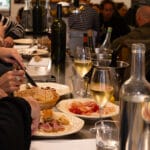 March 19, 2024 À Moro
March 19, 2024 À Moro
In a small dining room with Italian terrazzo floors, warm lighting, and earthy, […] Posted in Marseille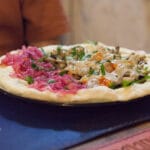 March 15, 2024 Tamtaki
March 15, 2024 Tamtaki
The Vera district of Tbilisi is bursting with tempting food options, from traditional […] Posted in Tbilisi March 1, 2024 Pancholi-na
March 1, 2024 Pancholi-na
Last summer, when we first saw handmade posters on the street written in English and […] Posted in Tbilisi
Published on November 13, 2023
Related stories
March 19, 2024
MarseilleIn a small dining room with Italian terrazzo floors, warm lighting, and earthy, distressed walls, every table is occupied. There are regulars from the neighborhood, couples on a quiet afternoon date, a father and small son giggling over pasta, and colleagues sharing plates at a long table in the corner. We grab the only seats…
March 15, 2024
TbilisiThe Vera district of Tbilisi is bursting with tempting food options, from traditional Georgian feasts to cinnamon rolls and pizza. But there is nowhere like Tamtaki in the neighborhood – or anywhere else in Tbilisi, for that matter. Founded by chef Tamta Kikaleishvili and her mother, Katya Gegia, in 2020, the origin of the name…
March 1, 2024
Tbilisi | By Clément Girardot
TbilisiLast summer, when we first saw handmade posters on the street written in English and Georgian announcing the opening of a Japanese bakery, we were both bewildered and excited. On top of many local tone (traditional ovens), Tbilisi had French, German, Turkish and Lithuanian bakeries – but Japanese bread and pastries were unheard of. We…







































